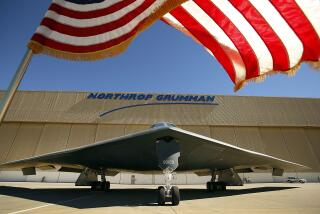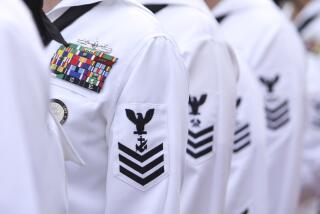Point Mugu Test Center, 3 Others to Be Consolidated : Military: The facilities in California and New Mexico will be united under one command. The change is meant to streamline weapons development and save millions of dollars.
On Tuesday afternoon, a two-man color guard at the Pacific Missile Test Center on the Point Mugu Naval Air Station will haul down the facility’s old eagle-and-anchor flag and unfurl a new flag emblazoned with a missile-firing jet fighter.
The act will take only a few minutes.
But it will symbolize a much larger shift already under way in the center’s role in U.S. naval warfare--a change so wide-ranging that its full effects won’t be fully known until 1995, but so subtle that it is happening without a single layoff or early retirement.
In a move meant to streamline weapons development and save taxpayers $115 million over the next three years, the U.S. Department of Defense is consolidating Point Mugu and three other naval weapons test labs--at China Lake, Calif., Albuquerque and White Sands, N.M.--under one command.
As of Tuesday, all four labs will be overseen by headquarters based at Point Mugu under the direction of the station’s own Adm. William E. Newman, who will be officially installed that afternoon as weapons division commander.
Once the consolidation is complete, the labs will function as a single, 53,000-square-mile firing range and laboratory for testing smart bombs and heat-seeking missiles, computerized anti-aircraft guns and high-powered lasers.
“We’re not closing anything down, we’re not throwing anybody out in the street,” said Bob Hubbert, a Point Mugu spokesman. “We are not, for all practical purposes, physically changing. We are changing what we do and the way we do it.”
The hoisting of the jet fighter flag over the headquarters of the newly named Naval Air Warfare Center weapons division will also symbolize the end of what has been a fat time for defense contractors.
Before the consolidation began in October, the testing labs at Point Mugu and China Lake often found themselves locked in fierce competition to develop and test the same weapons and software. Research and testing of Sparrow and Tomahawk missiles, for instance, often took place simultaneously at both Point Mugu and China Lake under multimillion-dollar contracts that achieved virtually the same goals.
Now, the missiles will be developed and built at China Lake, then shipped to Point Mugu for testing, officials said.
By March, a new laboratory will open at Point Mugu where scientists can run simulated attacks and obstacle courses past stationary missiles without conducting test firings, which cost about $1 million apiece, officials said.
Navy officials said the biggest savings will come from reducing staff at all four sites and centralizing their command at Point Mugu.
Commanders at Point Mugu say that by 1994 or 1995 they expect to have reduced the number of employees in the weapons division by 20% through attrition and a wave of scheduled retirements.
Although the labs merger was begun in October, Point Mugu itself began staff reduction in 1990 with a hiring freeze after Congress passed the Defense Base Closure and Realignment Act.
The test center’s commanders past and present, Adm. George H. Strohsahl Jr. and Newman, had already begun discussing the consolidation with China Lake’s commanders in 1990, well before it was mandated in a bill that was signed into law on Jan. 2, 1992, officials said.
“Adm. Strohsahl got us together at China Lake and talked about what might be happening, and what could we do to get ahead of the game,” said Gerald Wrout, executive director of the Point Mugu testing facility.
“Adm. Newman had the foresight to put the plan into action,” added air station Executive Officer Steve Glidden. “It’s certainly better to have an option than to have somebody tell you how to do it.
“It’s been very detailed, very work-intensive,” Glidden said of the restructuring of command and staffing, which included consolidating Point Mugu’s four separate flight schedules for various testing and patrol duties into one master schedule.
“We spent a lot of man-hours on how we were going to come to what we’ve evolved into, and to do that with a minor uprooting of people,” he said.
As a result, it forced the transfer of only a few upper-level program directors and caused none of the layoffs that accompanied recent changes and closings at other military installations.
“Our people are fine with it,” said Bonnie Brown, regional director for AFL-CIO union locals representing civilian employees at Point Mugu and China Lake.
“We figure it’s going to broaden our area so we could have interdepartmental transfers. So if our people don’t want to live on the ocean anymore at Point Mugu, they can move inland to China Lake without changing employers.”
Although the recession is forcing an increasing number of Point Mugu employees to stick with their jobs, 384 of 7,000 civilian employees left their jobs there last year, and the station should meet the reduction goals, said Navy management analyst Bob Mason.
The consolidation plan also calls for the Navy to change its dealings with military contractors, said Bob Warnagieris, who is executive director of the missile test center and the top civilian there.
Instead of brokering all weapons contracts worth more than $500,000 through the Navy procurement office in Long Beach, the Naval Air Warfare Center will do its own contract administration at China Lake, he said.
The goal is to shorten the time needed to get the Navy’s approval for weapons spending and to compress dozens of smaller contracts into a lesser number of large contracts, Warnagieris said.
Defense industry experts and Ventura County defense contractors said the consolidation will have little effect on local companies: They already have absorbed widespread layoffs and trimmed their operations in response to earlier defense cuts, the officials said.
McLaughlin Research, based in Camarillo, recently negotiated a five-year, $10-million contract to do periodic reliability checks on missiles already in service such as the Sidewinder and AMRAAM, said Andrew Cook, the company’s operations manager.
The new pact is half the size of the previous contract, but the company already had laid off nearly 100 of its 130 employees before the consolidation began, he said.
“The consolidation hasn’t really hurt us. No one knows what’s going to happen yet,” Cook said. “I think we’re going to see smaller contracting activities that are highly specialized . . . . I don’t think we’re going to see any huge contracts anymore.”
But some industry experts have criticized the consolidation plan, saying it is imprudent to hobble military testing in times of global turmoil and to limit weapons experiments that could give the U.S. military a technological edge over other nations.
“I would like to see perhaps a little bit more time pass before I’d rush to dismantle the national insurance policy,” said Wolfgang Demisch, a market analyst for UBS Securities in New York.
“I think having a somewhat more vibrant and aggressive set of contractors and government personnel working on the problem and trying to beat similar teams at a different site has always been a lot more constructive,” Demisch said. “I’m a great believer in wasting money in research.”
However, defense contractor Wally Boeck said the waste at the weapons labs has been needless.
“We can’t afford the overhead that we as taxpayers are paying,” said Boeck, center director of Computer Sciences Corp., a Camarillo-based systems company that serves Point Mugu.
“It’s inefficiency that’s producing the overhead . . . the layering of management on management” at the weapons labs, he said.
However, Boeck also said expensive experimentation helped produce the weapons that won the Persian Gulf War.
“Does it cost a million bucks to shoot a missile? Maybe,” Boeck said. “But does the missile take out a square block of downtown with a lot of Iraqi chemical warfare plants around? Then the answer is yes, it’s been worth it.”
For all the work that has gone into the consolidation, its ultimate result won’t be known for at least 2 1/2 years, said Wrout of the Point Mugu testing facility.
“Every time we looked at a way of doing business, we tested it,” Wrout said.
“We asked two questions,” Wrout said. “One, are we going to improve the product for the fleet? And two, could we look Congress and the taxpayer in the eye and say it was going to be a better way to do business?”
More to Read
Sign up for Essential California
The most important California stories and recommendations in your inbox every morning.
You may occasionally receive promotional content from the Los Angeles Times.










